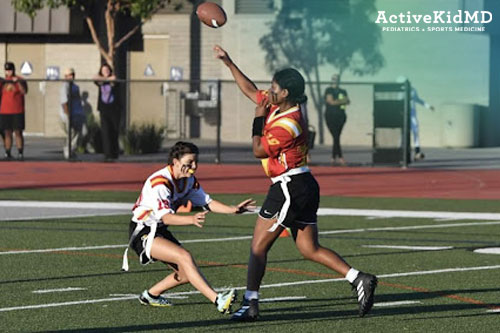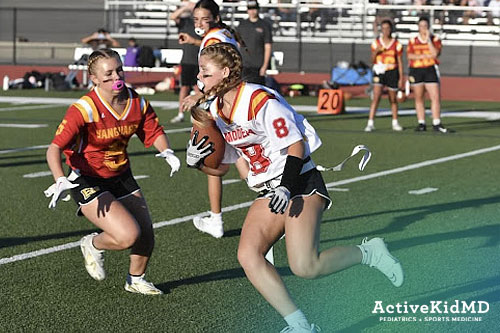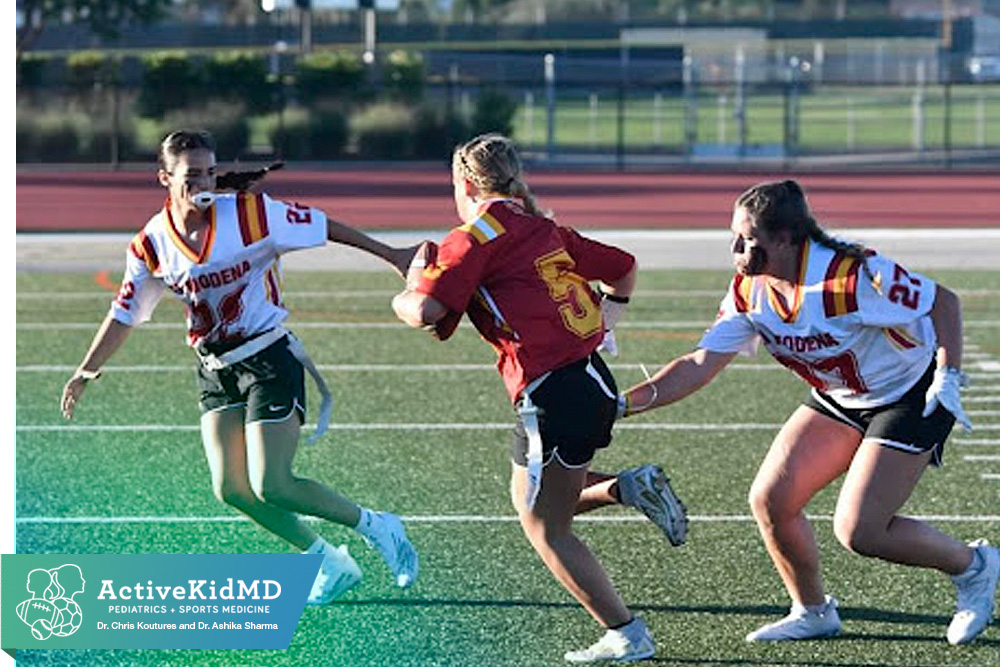As I write this, the inaugural season of high school flag football in the California Interscholastic Federation (CIF) Southern section has come to an end. During this initial season, I was able to work with some remarkable players and was impressed with their passion for the game. Unfortunately, a flag football-related injury was the reason I had to see most of these athletes.
Since flag football is so new, we don’t have much past information on injury types and patterns – especially within the high school population. A quick literature search only resulted in four articles under the heading “flag football injuries,” with the most comprehensive dated in 2013.

Photographed by James Vallejos
At the completion of this historic first season, there is another opportunity to make history. I am putting together a list of suggestions that can contribute to the safety of flag football athletes. So, I’m calling players, coaches, athletic trainers, other sports medicine colleagues, and parents. I humbly invite you all to share your experiences and thoughts.
If you have data (and yes, I’m calling my school-based athletic trainers to confidentially share injury logs and reports) then this will enable us to be better prepared to advocate for flag football players. If you were on the ground as a player, coach, parent, or official, what did you see and what could be done better?
Once I have all this information, I would like to produce an evidence-based list of suggestions and share with CIF decision makers.
I’ll start the conversation with some observations and hope to add many more. Most of these thoughts come from discussions with patients, parents, and ATC colleagues. I am grateful for this insight and would be even more appreciative of additional contributions!
1. I saw many flag football players in the early and mid-summer for preparticipation physicals. Most were coming from other sports (big props to the multi-sport athlete) and playing competitive flag football for the first time. How much of a factor was the relative inexperience with running and catching movement patterns in flag football? Would this be less of an issue as players bring more flag football experience to future seasons?
2. I didn’t see many injuries over the summer or the first few weeks of gameplay. Not that I was anticipating a big rush of injured players, but the early absence of player visits was encouraging.
3. By the end of September, there was a significant increase in the number of injury visits for flag football players. The other significant observation was that most injuries were more complicated types like concussions and knee anterior cruciate ligament (ACL) tears.
4. I began to wonder why there was an abrupt midseason increase in visits and complexity and came up with some possible reasons:

Photographed by James Vallejos
A. Did players change the way they play? Many players (and parents) admitted that as the season went on, there was more aggressive play. Some initial hesitation on how to pull flags gave way to higher levels of contact and collision (it was like “tackle the flag” in late season games as I was told).
B. Were there more complicated schemes? As players gained proficiency and confidence, and teams began to see other teams for the second or even third time, could dialing up higher level plays (power rushes or crossing receivers) lead to more injuries?
C. Was there player fatigue? Some teams were playing several days a week and often playing 2 games on a single day. Could there be a component of cumulative fatigue due to this type of schedule? Would schedule changes and perhaps more/different conditioning programs contribute to less acute or overload injuries?
D. Speaking of relative inexperience (by no means am I being critical), but was wondering if the officials were given the training and tools to enforce rules and foster a safer environment for players?

Photographed by James Vallejos
I’ll stop there with my initial list of thoughts and again, there is no intent to point fingers or cast blame on player injuries. Rather, the goal should be to gather as much evidence as possible to make sensible suggestions to protect flag football players. These could include pre-season conditioning programs (on-field and in the weight room), changes in scheduling, different emphasis on rule enforcement limiting excessive contact and collision, and perhaps changes in protective equipment (I know someone will bring up soft helmets). My bias after seeing them used in 7 on 7 play is that they give a false sense of security and may lead to more aggressive play, but I am certainly open to other views.
My hope for next season is to see fewer injured athletes in the office and hear more about their amazing plays on the field.
Join The Conversation!
Photo Credit: James Vallejos (Instagram @biggamejames66)




